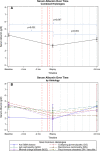COVID-19 Vaccination and New Onset Glomerular Disease: Results from the IRocGN2 International Registry
- PMID: 36996301
- PMCID: PMC10103269
- DOI: 10.34067/KID.0006832022
COVID-19 Vaccination and New Onset Glomerular Disease: Results from the IRocGN2 International Registry
Abstract
Key Points:
IgAN and MCD are the most common de novo glomerular diseases reported after COVID-19 vaccination, particularly after mRNA vaccination.
Membranous nephropathy, pauci-immune GN, and collapsing GN have also been attributed to COVID-19 vaccination, some with dual histologies.
Recovery of kidney function and proteinuria remission is more likely in IgAN and MCD by 4–6 months compared with the other glomerular diseases.
Background: Patients with de novo glomerular disease (GD) with various renal histologies have been reported after vaccination against SARS-CoV-2. Causality has not been established, and the long-term outcomes are not known. To better characterize the GDs and clinical courses/outcomes, we created the International Registry of COVID-19 vaccination and Glomerulonephritis to study in aggregate patients with de novo GN suspected after COVID-19 vaccine exposure.
Methods: A REDCap survey was used for anonymized data collection. Detailed information on vaccination type and timing and GD histology were recorded in the registry. We collected serial information on laboratory values (before and after vaccination and during follow-up), treatments, and kidney-related outcomes.
Results: Ninety-eight patients with GD were entered into the registry over 11 months from 44 centers throughout the world. Median follow-up was 89 days after diagnosis. IgA nephropathy (IgAN) and minimal change disease (MCD) were the most common kidney diseases reported. Recovery of kidney function and remission of proteinuria were more likely in IgAN and MCD at 4–6 months than with pauci-immune GN/vasculitis and membranous nephropathy.
Conclusions: The development of GD after vaccination against SARS-CoV-2 may be a very rare adverse event. Temporal association is present for IgAN and MCD, but causality is not firmly established. Kidney outcomes for IgAN and MCD are favorable. No changes in vaccination risk-benefit assessment are recommended based on these findings.
Figures




Comment in
-
New Onset Glomerular Disease Post-COVID-19 Vaccination: Is There a Link?Kidney360. 2023 Mar 1;4(3):294-296. doi: 10.34067/KID.0000000000000073. Kidney360. 2023. PMID: 36996293 Free PMC article. No abstract available.
References
Publication types
MeSH terms
Substances
LinkOut - more resources
Full Text Sources
Medical
Miscellaneous

